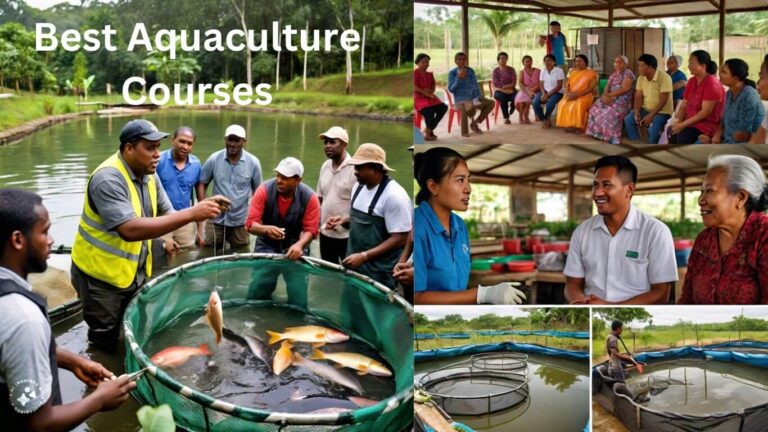Plastic fish ponds have become increasingly popular in aquaculture due to their ease of use, flexibility, and affordability.
This comprehensive guide explores the numerous advantages and disadvantages of plastic fish ponds, providing detailed insights into their construction, maintenance, and suitability for various aquaculture environments.
We will also examine the critical factors to consider when selecting a site for establishing a plastic fish pond.
Introduction to Plastic Fish Ponds
Plastic fish ponds, often constructed from robust, UV-resistant plastic sheets, have emerged as a versatile alternative to traditional fish farming methods. These ponds are lightweight, durable, and easy to install, making them an ideal choice for both newbies and experienced fish farmers. Their adaptability allows them to fit into various landscapes, catering to different farming needs.
Types of Plastic Used
The two most common types of plastic materials used in the construction of fish ponds are:
– High-Density Polyethylene (HDPE): Renowned for its toughness and chemical resistance, HDPE is the go-to choice for large-scale and permanent installations. Its ability to withstand extreme weather conditions makes it a reliable option for long-term use.
– PVC (Polyvinyl Chloride): More flexible and lighter than HDPE, PVC is suitable for smaller or temporary setups. Its pliability allows for easy customization and relocation if necessary, making it a favorite among small-scale fish farmers.
Factors to Consider When Selecting a Site for Plastic Fish Pond
Choosing the right site is crucial to the success of any fish farming operation. Here are the key factors to consider:
1. Soil Type and Permeability
The soil must be firm enough to support the pond structure without causing undue stress on the plastic. Avoid sandy or loose soil as it may shift and cause the pond to sink or the walls to collapse.
Ideally, the soil should be slightly clayey, providing a good foundation and some natural seepage control.
2. Topography
The site should have a gentle slope to facilitate water drainage and prevent flooding. Avoid steep slopes as they may pose a risk of soil erosion and make it challenging to construct a level pond.
3. Water Source and Quality
Ensure proximity to a reliable and clean water source. The water quality should be high, free from pollutants and contaminants that could harm the fish. Access to freshwater sources like rivers, streams, or boreholes is advantageous. You have to note that the quality of the water determines the survival and growth of your fish. So don’t joke with that.
4. Sunlight and Temperature
Consider the amount of sunlight the site receives. While sunlight is necessary for maintaining water temperature and promoting algal growth, excessive exposure can lead to overheating, especially in shallow ponds. Partial shading or controlled sun exposure is ideal.
5. Accessibility
The site should be easily accessible for regular maintenance, feeding, and harvesting. Proximity to transportation routes is also essential for the efficient supply of inputs and the delivery of fish to markets.
6. Environmental Impact
Assess the potential environmental impact of the pond on the surrounding ecosystem. Ensure that the pond does not disrupt local wildlife, vegetation, or water bodies. Implement measures to minimize any negative effects on the environment.
Advantages of Plastic Fish Ponds
Plastic fish ponds offer several benefits that have contributed to their widespread adoption in aquaculture. Here’s a detailed look at these advantages:
1. Cost-Effectiveness
Plastic fish ponds are significantly cheaper to install compared to traditional concrete or earthen ponds.
The materials required for their construction are relatively inexpensive, and the process itself is straightforward, reducing labor costs.
This affordability makes plastic ponds an attractive option for both new and experienced fish farmers.
2. Easy Installation and Setup
The lightweight nature of plastic sheets simplifies the installation process. Plastic ponds can be assembled quickly without the need for heavy machinery or specialized labor.
This ease of setup allows farmers to establish their operations swiftly, responding to market demands or scaling their production with minimal downtime.
3. Flexibility and Adaptability
Plastic ponds are highly adaptable, allowing for customization to fit specific farm layouts and space constraints.
They can be easily expanded, reduced, or reshaped to meet changing needs, such as accommodating different fish species or increasing production capacity.
4. Low Maintenance
The smooth surface of plastic ponds minimizes algae growth and other contaminant buildup, making cleaning and maintenance less labor-intensive.
Additionally, plastic materials are resistant to corrosion and chemical damage, ensuring a longer lifespan with minimal upkeep.
5. Temperature Control
Plastic ponds provide excellent insulation, helping maintain stable water temperatures. This is crucial for the optimal growth of fish, as temperature fluctuations can stress the fish and hinder their development. The insulating properties of plastic help create a conducive environment for fish farming, particularly in regions with varying climates.
6. Environmental Friendliness
Modern plastic materials are designed to be eco-friendly, reducing the overall environmental impact of fish farming. They do not release harmful chemicals into the water, ensuring a safe and healthy habitat for aquatic life. Moreover, plastic ponds can be recycled or repurposed at the end of their life cycle, contributing to sustainable farming practices.
Disadvantages of Plastic Fish Ponds
While plastic fish ponds offer numerous benefits, they also have certain limitations that need to be addressed:
1. Durability Concerns
Despite their resistance to corrosion and chemicals, plastic ponds can still be susceptible to physical damage from sharp objects or heavy equipment. Care must be taken to prevent punctures or tears, which could lead to leaks or structural failure.
2. Limited Lifespan
Compared to more permanent structures like concrete or earthen ponds, plastic ponds have a shorter lifespan. Although high-quality plastics can last several years, they will eventually degrade due to exposure to sunlight, weather, and other environmental factors. This necessitates periodic replacements, which can increase long-term costs.
3. Potential for Leaks
Improper installation or damage to the plastic sheets can lead to leaks, affecting water levels and quality. Regular inspections and prompt repairs are essential to prevent water loss and maintain a healthy environment for the fish.
4. Aesthetic Limitations
Plastic ponds may not blend seamlessly with the natural surroundings, potentially detracting from the overall visual appeal of the farm. This could be a concern for those aiming to create a more natural or picturesque landscape.
5. Chemical Sensitivity
Certain chemicals, including some pesticides and disinfectants, can react adversely with plastic materials, compromising the pond’s integrity. Farmers must be cautious in their use of chemicals, opting for fish-safe alternatives and adhering to recommended dosages.
6. Weight Limitations
Plastic ponds may not be suitable for very large-scale operations where the weight of the water and fish could strain the material. In such cases, more robust alternatives like concrete or earthen ponds may be necessary to support the increased load.
Best Practices for Using Plastic Fish Ponds
To maximize the benefits and mitigate the disadvantages of plastic fish ponds, consider the following best practices:
1. Regular Inspection and Maintenance
You need to perform regular inspections to identify and address any damage or leaks promptly. This proactive approach helps extend the lifespan of the pond and maintain optimal conditions for the fish.
2. Proper Installation
Ensure the pond is installed correctly, follow manufacturer guidelines and seek professional assistance if necessary. Proper installation minimizes the risk of leaks and structural issues.
3. Use of Protective Measures
Implement protective measures, such as installing a cover or shade structure, to reduce the impact of extreme temperatures and UV exposure on the plastic material. This helps prevent premature degradation and extends the pond’s lifespan.
Also cover the pond with net to prevent predators from predating the fish.
4. Chemical Management
Carefully manage the use of chemicals within the pond, selecting fish-safe options and following recommended dosages to avoid damaging the plastic. Regular water testing and monitoring can help maintain a safe and healthy environment.
5. Monitoring Water Quality
Consistently monitor water quality parameters, including temperature, pH, and dissolved oxygen levels, to ensure a conducive environment for the fish.
Plastic ponds provide good control over these factors, but consistent monitoring is essential for optimal fish health and growth.
You need to have the right monitoring test kit to always determine the quality of the water at any given time.
Conclusion
Plastic fish ponds offer a range of advantages, making them a viable option for many fish farmers. Their cost-effectiveness, ease of installation, and flexibility make them an attractive choice for both small-scale and large-scale operations.
However, potential drawbacks such as durability concerns and limited lifespan must be taken into account.
By following best practices and regularly maintaining the pond, fish farmers can enjoy the benefits of plastic ponds while minimizing the associated risks.





